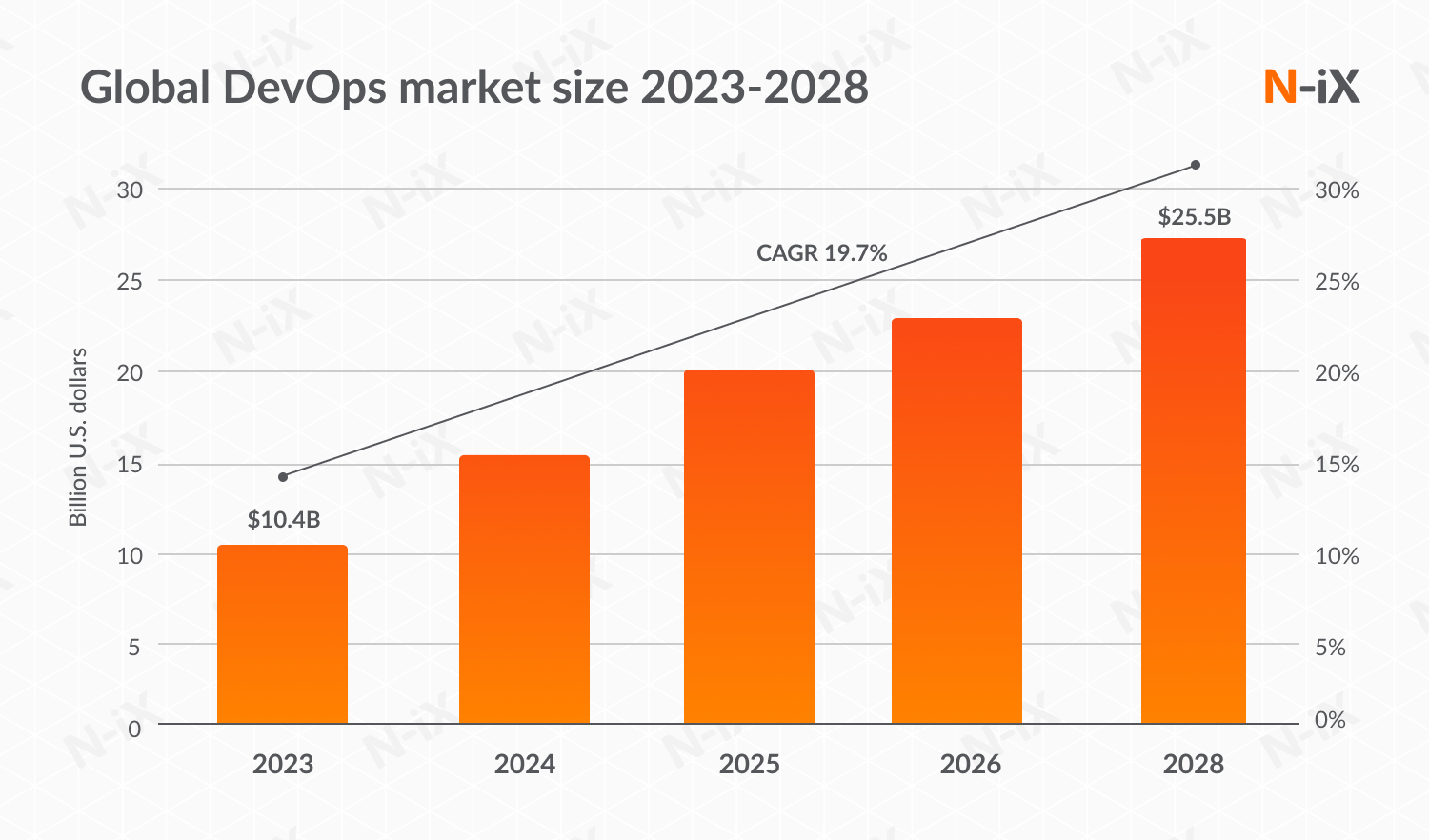Introducing DevOps brings many benefits for businesses, from improved efficiency to faster time-to-market and optimized expenses. This causes more and more organizations to seek to incorporate DevOps into their operations. As a result, the DevOps market is booming, reaching $10.4B in 2023, with expected growth to an estimated $25.5B by 2028.
However, adopting DevOps requires careful planning. A clear picture of how prepared your organization is for such an endeavor is fundamental to your success. That's where a DevOps maturity model comes in–a framework or set of guidelines designed to assess an organization's level of maturity in implementing DevOps practices and principles. But which model should you choose? How do you apply it? And which metrics do you need to evaluate? Read on to find out.

What is the importance of a DevOps maturity model for a business?
The model evaluates multiple aspects of your DevOps practices, such as the presence of silos, the speed and quality of releases, adherence to principles, collaboration levels, automation adoption, tool stacks, and more. This evaluation serves several purposes for organizations:
- Evaluate and compare existing DevOps capabilities and practices;
- Determine the target level of maturity you aim to achieve;
- Prioritize areas that require improvement;
- Develop a strategic roadmap for advancing to higher maturity levels;
- Get more insight into DevOps best practices, security protocols, and relevant performance metrics.
Which DevOps maturity model should you choose?
There are quite a few models businesses use to assess and improve their DevOps practices. However, not all have shown consistent results or been sufficiently validated. Therefore, sticking with the well-established and commonly used ones is highly recommended. Let's take a brief look at what these are.
Capability Maturity Model Integration (CMMI)
CMMI is widely recognized and accepted as a maturity model for assessing organizational capabilities. It covers various organizational capabilities beyond DevOps, making it helpful in assessing the overall operational maturity of your business. Additionally, CMMI provides a structured framework for maturity assessment, making it easier for organizations to identify areas for improvement.
The main drawback of this model is that, due to its broad coverage, it may not provide a precise assessment of DevOps maturity.
Additionally, the model itself is rather complex, and implementing it can be difficult and resource-intensive, which might be especially challenging for smaller organizations or teams. However, this can be remedied by acquiring assistance from a tech partner specializing in DevOps consulting.
CALMS Model (Culture, Automation, Lean, Measurement, Sharing)
CALMS provides a holistic view of DevOps maturity, covering cultural, automation, lean practices, measurement, and sharing aspects. It closely aligns with DevOps principles, making it a practical choice for assessing DevOps maturity. Furthermore, it emphasizes the importance of collaboration and cultural aspects, which are fundamental to success with DevOps.
However, the model has its challenges. Firstly, it is less structured as compared to other models like CMMI. This can make it more difficult to implement, especially if your organization is new to DevOps assessments. Secondly, some aspects of CALMS, such as culture and sharing, are highly subjective and may be challenging to assess objectively. Nevertheless, similarly to the CMMI model, experienced DevOps engineers can help you overcome these challenges relatively easily.
IBM DevOps Maturity Model
This model is designed to assess an organization's DevOps capabilities, ensuring relevance. It offers a detailed evaluation of various DevOps dimensions, such as planning, development, testing, and delivery. What's more, it is highly customizable, allowing you to tailor your assessment to your business's specific goals and needs.
This model has close ties to IBM's DevOps tools and practices, which could limit its suitability for organizations not using IBM's solutions. Because of this, it does not have the same level of recognition and industry-wide adoption as the previously mentioned models.
DevOps maturity assessment: step-by-step process
Applying a model to assess an organization's DevOps maturity is a straightforward process divided into several steps. Let's use the approach of N-iX–a global software solutions and engineering company–as an example.
- Preparation: we get everything ready for kick-off, including determining the target audience and identifying key assessment questions.
- Assessment: this is where the main portion of our work takes place, as our experts perform qualitative analysis according to the industry's best practices to identify risks, issues, and improvement opportunities.
- Report creation: after the assessment is complete, we create a report with a detailed description of our findings, their impact on the business, mitigation strategies, their priority, and complexity.
- Improvement roadmap: finally, we deliver an improvement roadmap with clearly defined objectives, prioritized tasks, and identified dependencies, as well as an ability to allocate the resources and monitor the progress.

Key metrics for evaluating DevOps maturity
So, what specific aspects are evaluated regarding processes and protocols when determining your current DevOps maturity level? Let's find out.
Culture
Evaluating the cultural transformation and alignment within the organization is crucial. This involves assessing factors like collaboration, communication, knowledge sharing, education, planning processes, and the willingness of teams to work together towards shared DevOps goals.
Leadership and commitment
Leadership plays a pivotal role in driving DevOps adoption. Assessing leadership commitment to DevOps initiatives, their involvement, and their ability to foster a DevOps culture is essential. This also includes analyzing aspects such as innovation, flexibility, identifying and clearly communicating goals and strategies for achieving them, and more.
Technical Practices
This aspect delves into the technical capabilities and practices of the organization. This includes adopting DevOps best practices, software development methodologies, quality assurance processes, pipeline automation, systems and practices for source code control, tools and technologies selection, etc.
Infrastructure
Assessing the infrastructure involves evaluating the readiness of the IT environment, including the Infrastructure as Code approach, self-healing design, AI integration, chatOps, and cloud implementation and integration.
Security
Last but certainly not least, you need to ensure the security of your software development lifecycle. Amid the competitive landscape, it's easy to overlook security measures, potentially leaving vulnerabilities. Managed DevOps aims to mitigate this risk by prioritizing strict security standards throughout all phases of software development. Implementing Security as Code and DevSecOps maturity assessment can be a valuable consideration to enhance security practices.
The 5 levels of DevOps maturity
Typically, a DevOps maturity model consists of several levels or stages, each representing a different level of your organization's maturity or proficiency in DevOps practices. These levels can vary in terminology and specifics but often follow a progression from initial, ad-hoc practices to more advanced, automated, and optimized processes. They include:
Stage 1: Initial
At this stage, minimal DevOps practices are in place, and the development and operations teams work in silos with little collaboration. Changes and deployments are manual and infrequent.
Stage 2: Managed
The organization starts formalizing and documenting some of its processes in this stage. There is an awareness of the need for collaboration between teams, and basic automation begins to emerge.
Stage 3: Defined
Your organization establishes well-defined and documented development, testing, and deployment processes. Collaboration between your teams is encouraged and supported, and automation is expanded.
Stage 4: Quantitatively Managed
At this level, there is a strong emphasis on metrics and monitoring to track performance and quality. Continuous integration and continuous delivery (CI/CD) pipelines are established, and you focus on proactive problem-solving.
Stage 5: Optimized
This is the highest level of maturity, where DevOps practices are fully integrated into your organization's culture. A strong focus is on continuous improvement, automation, and self-service capabilities. Your business is agile and can quickly adapt to changes and challenges.

Wrap up
A DevOps maturity model is crucial in helping businesses evaluate their infrastructure and adopt practices to facilitate their transition into fully optimized organizations. Since choosing the most fitting model and evaluating all the necessary metrics can be hard work, partnering with DevOps consultants who specialize in that is highly recommended. This will allow you to achieve improved efficiency, better resource allocation, faster time to market, and other benefits of effective DevOps adoption.
What makes N-iX an ideal partner for evaluating your DevOps maturity?
- N-iX has over 60 DevOps engineers who will assess your organization's DevOps maturity and provide their expertise to help you reach the desired level of optimization;
- With 23 years of experience and 50+ successfully delivered DevOps projects, N-iX is more than capable of matching all your optimization needs;
- N-iX is well-versed in all cloud technologies, being an AWS Advanced Tier Service Partner, a Microsoft Solutions Partner, and a Google Cloud partner;
- We comply with ISO 9001, ISO 27001, PCI DSS, and GDPR data protection standards, ensuring your sensitive data remains protected.
Get your guide to building an effective CI/CD pipeline!


Success!

Have a question?
Speak to an expert




